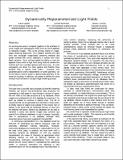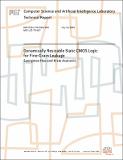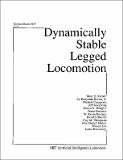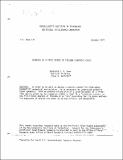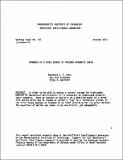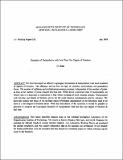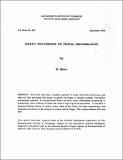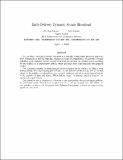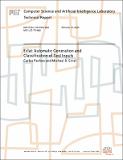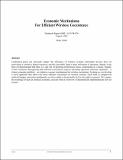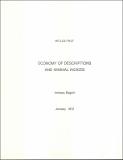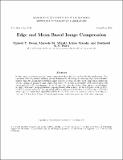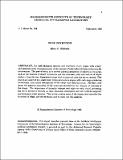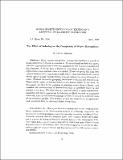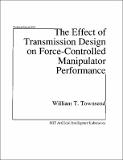Browsing Computer Science and Artificial Intelligence Lab (CSAIL) by Title
Now showing items 1015-1034 of 3804
-
Dynamically Resizable Static CMOS Logic for Fine-Grain Leakage
(2004-07-12)Digital circuits often have a critical path that runs through a smallsubset of the component subblocks, but where the path changes dynamicallyduring operation. Dynamically resizable static CMOS (DRCMOS) logic isproposed ... -
Dynamically Stable Legged Locomotion (September 1985-Septembers1989)
(1989-09-01)This report documents our work in exploring active balance for dynamic legged systems for the period from September 1985 through September 1989. The purpose of this research is to build a foundation of knowledge that ... -
The Dynamicist's Workbench: I Automatic Preparation of Numerical Experiments
(1987-05-01)The dynamicist's workbench is a system for automating some of the work of experimental dynamics. We describe a portion of our system that deals with the setting up and execution of numerical simulations. This part of ... -
Dynamics of a Three Degree of Freedom Kinematic Chain
(1977-10-01)In order to be able to design a control system for high-speed control of mechanical manipulators, it is necessary to understand properly their dynamics. Here we present an analysis of a detailed model of a three-link ... -
Dynamics of a Three Degree of Freedom Kinematic Chain
(MIT Artificial Intelligence Laboratory, 1977-10)In order to be able to design a control system for high-speed control of mechanical manipulators, it is necessary to understand properly their dynamics. Here we present an analysis of a detailed model of a three-link device ... -
Dynamics of Manipulators with Less Than One Degree of Freedom
(MIT Artificial Intelligence Laboratory, 1983-01)We have developed an efficient Lagrangian formulation of manipulators with small numbers of degrees of freedom. The efficiency derives from the lack of velocities, accelerations, and generalized forces. The number of ... -
The Early Detection of Motion Boundaries
(1990-05-01)This thesis shows how to detect boundaries on the basis of motion information alone. The detection is performed in two stages: (i) the local estimation of motion discontinuities and of the visual flowsfield; (ii) the ... -
Early Processing of Visual Information
(1975-12-01)The article describes a symbolic approach to visual information processing, and sets out four principles that appear to govern the design of complex symbolic information processing systems. A computational theory of ... -
Early Sketch Processing with Application in HMM Based Sketch Recognition
(2004-07-28)Freehand sketching is a natural and crucial part of everyday humaninteraction, yet is almost totally unsupported by current user interfaces. With the increasing availability of tablet notebooks and pen based PDAs, sketchbased ... -
Early-Delivery Dynamic Atomic Broadcast
(2002-04) -
An Ease of Use Evaluation of an Integrated Editor and Formatter
(1981-01)Etude is an integrated text editor and formatter that was designed to be easy to learn and easy to use. To measure Etude's success in meeting these goals, twenty-one computer-naive temporary office workers were taught to ... -
Eclat: Automatic Generation and Classification of Test Inputs
(2004-10-14)This paper describes a technique that helps a test engineerselect, from a large set of randomly generated testinputs, a small subset likely to reveal faults in the softwareunder test. The technique takes a program or ... -
Economies of Scale in Computer Use: Initial Test and Implication A for the Computer Utility
(1970-06)This study is concerned with the existence of economies of scale in the production of data processing and other computing services, and the possible regulatory and public policy implications of such economies. The rapid ... -
Economy of Descriptions and Minimal Indices
(1972-01) -
Edge and Mean Based Image Compression
(1996-11-01)In this paper, we present a static image compression algorithm for very low bit rate applications. The algorithm reduces spatial redundancy present in images by extracting and encoding edge and mean information. Since ... -
Edge Detection
(1985-09-01)The goal of vision is to recover physical properties of objects in a scene, such as the location of object boundaries and the structure, color, and texture of object surfaces, from the two-dimensional image that is ... -
The Effect of Indexing on the Complexity of Object Recognition
(1990-04-01)Many current recognition systems use constrained search to locate objects in cluttered environments. Previous formal analysis has shown that the expected amount of search is quadratic in the number of model and data features, ... -
The Effect of Transmission Design on Force-Controlled Manipulator Performance
(1988-04-01)Previous research in force control has focused on the choice of appropriate servo implementation without corresponding regard to the choice of mechanical hardware. This report analyzes the effect of mechanical properties ...

